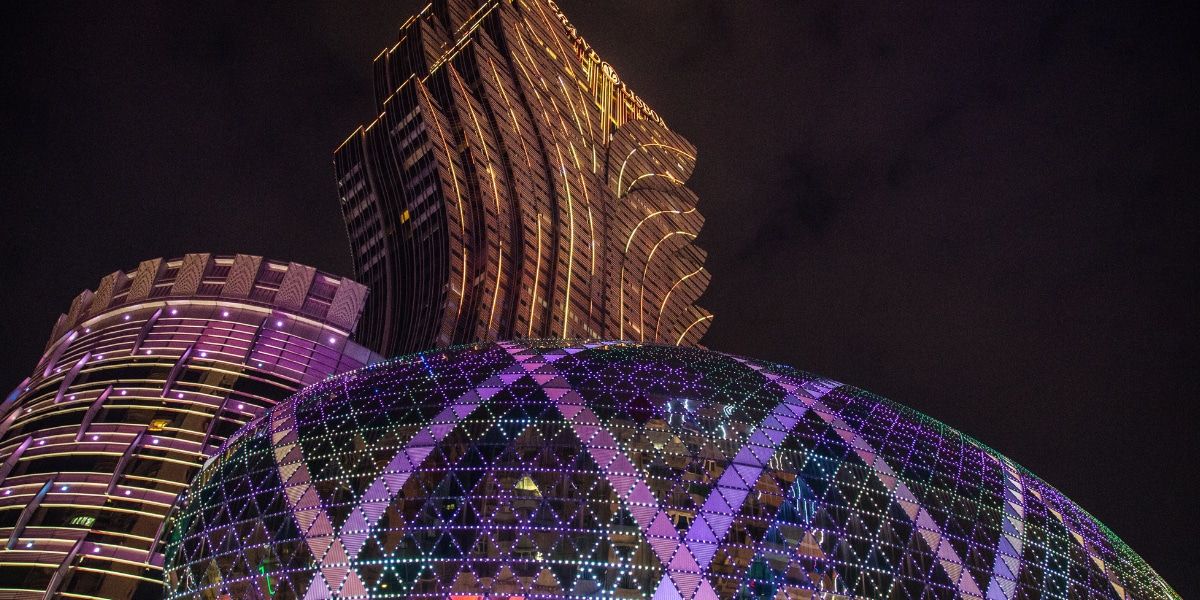Step into any casino, and you'll find yourself immersed in a world of glitz, glamour, and excitement. But have you ever stopped to consider the intricate design elements and psychological tricks at play? Welcome to our latest blog post.
In this fascinating exploration, we delve into the captivating world of casino architecture, a realm where artistry meets psychology to create an environment that entices, engages, and influences behavior. This topic is not only intriguing for those interested in architecture or psychology but also offers valuable insights for anyone who has ever set foot in a casino or plans to do so.
Understanding the architectural strategies employed by casinos can enhance your awareness and appreciation of these entertainment hubs. It's not just about the flashing lights and ringing slot machines; there's a whole science called casino design behind how these spaces are designed. From the maze-like layouts to the strategic use of lighting and sound, every detail is meticulously planned to create a unique atmosphere and influence patrons' behavior.
So, whether you're a casual visitor, a high roller, or simply someone intrigued by the intersection of architecture and psychology, this blog post promises to offer a wealth of knowledge about casino design. Let's pull back the curtain and uncover the secrets behind the captivating world of casino architecture.
Hostile Design in Casinos
The concept of hostile design in architecture is a fascinating one, and its application in casinos is particularly intriguing. Hostile design, also known as defensive or unpleasant design, is an architectural strategy that uses elements of the built environment to guide or restrict behavior intentionally. This strategy is often employed in public spaces to deter certain activities or behaviors, such as loitering or sleeping on benches. However, in the context of casinos, hostile design takes on a different role - it becomes a tool for influencing patrons' behavior to maximize profits.
Casinos are notorious for their labyrinthine layouts, with winding paths leading patrons past rows of enticing slot machines and gaming tables. This is no accident; it's a deliberate design choice intended to keep patrons inside the casino for as long as possible. The longer a patron stays, the more likely they are to spend money. This is where the concept of hostile design comes into play.

One of the most common applications of hostile design in casinos is the strategic placement of essential facilities such as bathrooms. Rather than being conveniently located, these facilities are often tucked away in hidden corners of the casino floor. The route to reach them invariably leads patrons past a plethora of high-traffic casino games. This intentional inconvenience serves a dual purpose: it not only keeps patrons inside the casino longer as they search for the facilities, but it also exposes them to more games along the way. The hope is that they will be tempted to join a game, especially if they see an excited crowd gathered around a table.
Another example of hostile design in casinos is the use of uncomfortable furniture. Much like the public benches designed to prevent people from lying down, casino furniture is often hard and uncomfortable to sit on for extended periods. This subtle discomfort encourages patrons to leave their seats and engage in more active pursuits - like gambling.
In conclusion, hostile design in casinos is a clever architectural strategy that manipulates the built environment to influence patrons' behavior subtly. By creating intentional inconveniences and using the layout to guide patrons' movements, casinos can increase their chances of keeping patrons engaged and spending money. It's a testament to the power of design and its ability to shape our actions in ways we may not even realize.
The Power of Reward-linked Stimuli
In the world of casino architecture and design, one of the most potent tools employed to influence gamblers' behavior is the use of reward-linked stimuli. These stimuli, often in the form of vibrant lights and captivating sounds, are strategically integrated into the gaming environment to create an immersive and thrilling experience for players.
A study published in JNeurosci, the journal from the Society for Neuroscience, on October 29th, 2018, delved into the psychology behind these reward-linked stimuli. The research revealed that sensory features such as the flashing lights and jingles associated with slot machines could directly influence a player's decisions, encouraging riskier choices. This finding raises concerns about the potential promotion of problem gambling.

The study further demonstrated that when wins were accompanied by casino jingles and money imagery, players paid less attention to information about the odds. This distraction, coupled with the arousal caused by winning outcomes paired with sensory cues, led to more risky decision-making. In essence, the brain's reward system, powered by the neurotransmitter dopamine, associates these intense feelings of pleasure with the act of gambling, reinforcing the behavior.
Moreover, another study conducted on August 17, 2022, used eye-tracker technology to discover that people were more aroused when winning outcomes were paired with sensory cues. This arousal, combined with the reduced attention to the odds, promoted risky decision-making, potentially leading to problem gambling.
How to protect yourself against reward-linked stimuli
Recognizing the influence of these reward-linked stimuli is the first step towards managing their effects. Here are some tips:
1. Awareness: Understand that casinos use lights, sounds, and other sensory cues to enhance the excitement of games and encourage you to take more risks.
2. Set Limits: Before you start gambling, set a limit on how much time and money you're willing to spend. Stick to these limits regardless of the sensory cues around you.

3. Take Breaks: Regular breaks can help you maintain perspective and resist the lure of the lights and sounds.
4. Know the Odds: Despite the distractions, make an effort to understand the odds of the games you're playing. This knowledge can help you make more informed decisions.
5. Seek Help: If you find it difficult to control your gambling behavior, don't hesitate to seek professional help. There are numerous resources available for those struggling with problem gambling.
In conclusion, while reward-linked stimuli contribute to the thrill of the casino experience, they can also lead to risky decision-making and potential gambling problems. Being aware of these influences and taking steps to manage them can help ensure that your gambling remains a fun and controlled activity.
The Role of Background Music
Music has a profound impact on our emotions and behavior, and in the world of casino architecture, it plays a pivotal role in shaping the gambling experience. The strategic use of background music in casinos is a subtle yet powerful tool that can influence players' moods, decision-making processes, and overall gambling behavior.

Research has shown that the tempo and volume of background music can significantly affect a player's perception of time, their level of excitement, and their willingness to take risks. Slow-tempo music, for instance, can create a relaxed atmosphere that encourages players to spend more time at the gaming tables or slot machines. On the other hand, fast-paced music can heighten players' arousal levels, stimulating them to place bets more quickly and take bigger risks.
The choice of music genre also plays a crucial role in setting the mood within a casino. For example, classical music can lend an air of sophistication and elegance, while pop or rock music can create a lively and energetic ambiance. These different atmospheres can subtly influence players' moods and attitudes towards gambling, potentially affecting their betting behavior.
How to protect yourself against the influence of background music
However, while background music can enhance the thrill and enjoyment of the casino experience, it's important to be aware of its potential influence and take steps to manage it. Here are some suggestions:
1. Awareness: Recognize that the music in a casino is not just for entertainment; it's a strategic tool designed to influence your gambling behavior.
2. Stay Focused: Try not to let the music distract you from your game strategy. Stay focused on the odds, your budget, and your betting decisions.
3. Use Earplugs: If you find the music too distracting or influential, consider using earplugs to block it out and maintain your concentration.

In conclusion, background music in casinos is a powerful psychological tool that can influence players' moods and behaviors. By understanding its effects and taking steps to manage its influence, players can ensure that they maintain control over their gambling experience.
Why do casinos have low ceilings?
Casinos are meticulously designed to optimize the gaming experience and encourage patrons to spend more time and money. One such design element is the use of low ceilings. The concept of low ceilings in casinos is rooted in psychology and energy efficiency.
From a psychological perspective, low ceilings create a sense of intimacy and coziness. This atmosphere encourages players to stay longer and engage more with the games. The absence of empty space above players' heads helps avoid a lofty, open barn effect, which could potentially make the space feel less inviting.
In terms of energy efficiency, rooms with lower ceilings have less air volume compared to those with high ceilings. This impacts the heating and cooling dynamics of the room, making temperature control more efficient. An evenly heated or cooled room feels more comfortable, further encouraging patrons to stay longer.

Moreover, many casinos lack windows and clocks, a tactic borrowed from traditional casino design. The absence of these elements makes it harder for gamblers to track time, leading them to spend more time at the tables.
Interestingly, some casinos even paint their ceilings to resemble the sky, adding to the illusion of an endless, timeless environment. This design trick further disorients patrons, making them lose track of time and prolong their stay.
These design strategies, including the use of low ceilings, are part of the sneaky tricks that casinos employ to maximize their profits. They play on human psychology and our natural responses to certain environments, ensuring that patrons spend as much time and money as possible within their walls.
What are the traditional principles of Bill Friedman's casino design?
Bill Friedman, a former gambling addict turned casino consultant, is renowned for his famous book and unique approach to casino design. His principles were developed through extensive research and observation of successful casinos, with the aim of maximizing player engagement and time spent within the casino.
Friedman's philosophy was centered around creating an environment that would keep players in the casino for as long as possible. He believed that the layout of the casino played a significant role in attracting and retaining players. His theory was so successful that it even influenced grocery store design.

One of Friedman's key principles was the concept of "gaming" design. This involved low ceilings, minimal decor beyond tables and machines, and a layout that always leads back to the casino's gambling area. He also advocated for the placement of gambling equipment immediately inside casino entrances, arguing that this would lure players into playing as soon as they entered the casino.
Another principle was the creation of a labyrinthine design to disorientate players. The idea was to make it difficult for players to find their way out, thereby encouraging them to stay and play longer. This was complemented by the use of narrow walkways and compact rooms to create an intimate and comfortable atmosphere that would make players feel at home.
Friedman also emphasized the importance of strategic placement of landmarks within the casino to help players easily locate themselves. He argued against wasting space and advocated for immediate availability of gambling activity upon entering the casino.
Friedman's principles have significantly influenced the design of many modern casinos. However, some of his ideas have been challenged by newer approaches to casino design, such as those proposed by Roger Thomas, who focused on creating a more relaxed and luxurious environment for players. Despite these evolving trends, Friedman's principles remain a cornerstone in the field of casino design.
List of Key Principles and Design Standards according to Bill Friedman
1. Gaming Design: Friedman advocated for a design that always leads back to the casino's gambling area. This involved low ceilings, minimal decor beyond tables and machines, and a layout that keeps players within the gaming environment.
2. Immediate Gambling Equipment Placement: According to Friedman, placing gambling equipment immediately inside casino entrances would lure players into playing as soon as they entered the casino.
3. Labyrinthine Design: To encourage players to stay and play longer, Friedman suggested creating a labyrinthine design that disorients players, making it difficult for them to find their way out.
4. Narrow Walkways and Compact Rooms: The use of narrow walkways and compact rooms was another principle advocated by Friedman. These elements create an intimate and comfortable atmosphere that makes players feel at home.
5. Strategic Landmark Placement: Friedman emphasized the importance of strategically placing landmarks within the casino to help players easily locate themselves.
6. No Wasted Space: Friedman argued against wasting space in a casino. He believed that every square foot of the casino should be utilized to promote gambling activity.
7. Immediate Availability of Gambling Activity: Upon entering the casino, Friedman believed that gambling activity should be immediately available to patrons.
These principles have significantly influenced the design of many modern casinos and continue to be a cornerstone in the field of casino design.
What are the modern principles of Roger Thomas' casino design?
Roger Thomas, a renowned interior designer known for his work on Las Vegas casinos, has revolutionized the design standards of the gambling industry. Born in 1951, Thomas grew up in Las Vegas and was instrumental in designing Wynn Resorts, transforming the industry with his unique approach to architecture and design.
Thomas's design philosophy is rooted in the concept of Evoca-tecture, a term coined to describe his innovative approach to creating luxurious, memorable, opulent, and seductive spaces. His designs are inspired by the decorative arts of various cultures, captured in his sketchbooks and transformed into captivating designs that seduce and captivate visitors.
One of the key principles of Thomas's design philosophy is the deliberate violation of traditional casino design rules. He believes in creating clear sight lines for easy navigation, installing antique timepieces and skylights to let in natural light, and breaking the rule prohibiting décor in gaming areas. His designs are unique, flaunting their uniqueness and becoming quirkier over time.
Thomas's designs also focus on creating an atmosphere that encourages people to gamble. He believes that people are more likely to place big, risky bets when they feel safe and relaxed. His designs aim to seduce visitors with a sense of magnificence, making them feel glamorous in a glamorous space and rich in a rich space.

In contrast to the traditional casino design principles advocated by Bill Friedman, which focused on low ceilings, little decor beyond tables and machines, and a layout that always leads back to the casino's gambling area, Thomas's designs are characterized by high ceilings swathed in silk fabric, European-style furnishings selected with scrupulous care, and elegant lobbies displaying massive art sculptures.
Thomas's design philosophy also extends to residential designs, where he uses his deep knowledge of art and craft and mastery of technique to create designs that reveal different aspects of his talents. His residential designs focus on a more personal kind of luxury, even serenity.
Thomas's innovative approach to casino design has been widely recognized and acclaimed. His designs have not only transformed the look of modern gambling halls but have also significantly contributed to the success of the establishments he has designed. His designs have led people to spend as they'd never spent before, generating unprecedented profits for the establishments.
What is the Casino Playground Design in Modern Casino Architecture?
The concept of "playground design" in casino architecture is a revolutionary approach that has transformed the traditional perception of casinos. This innovative design style, credited to Roger Thomas and Steve Wynn, aims to create an inviting, glamorous, and comfortable space that encourages guests to stay longer and spend more.
The playground design, first exemplified by the Bellagio hotel in 1998, breaks away from the conventional maze-like layouts of casinos that were designed to keep players gambling. Instead, it focuses on creating an environment that induces feelings of security, intimacy, freedom, and vitality. This is achieved through the use of warm colors, green spaces, moving water, and enticing sculptures. The design also incorporates ample sunlight and an open view, transforming the casino into a vibrant playground.

Slot machines, which traditionally lined the entire wall of the casino, are now placed in small clusters, adding to the sense of openness and freedom. High ceilings, excellent wayfinding, and glamorous lobby spaces further enhance the appeal of these casinos.
The psychology behind this design is rooted in the concept of “loss aversion.” In a casino setting, this means that players are more likely to continue playing to avoid losing their money, rather than to win more. The playground design effectively encourages guests to stay longer, bet and lose more money, leave feeling better, and return more frequently.
A key aspect of the playground design is the careful consideration of audio, visual, and lighting (AVL) features. The right AVL setup can significantly influence the atmosphere and the overall guest experience. For instance, well-lit casinos with colored lights and unique light fixtures create a luxurious and opulent feel. Audio systems playing background music at the right sound level can set the tone and mood for the guests. Video screens strategically placed around the casino can serve both functional and aesthetic purposes.
In conclusion, the playground design in casino architecture is a strategic blend of psychology, aesthetics, and technology aimed at enhancing the guest experience and boosting casino profits. It's a testament to the power of design in shaping human behavior and perceptions.
Ambitious Casino Design
Ambitious Architecture is a unique concept in casino design that aims to make players feel wealthier than they actually are. This is achieved through the use of opulent aesthetics and luxurious design elements that immerse players in the kind of lifestyle they desire. The idea is to create an environment that exudes wealth and luxury, making patrons feel like they are part of an exclusive club.

This approach to casino design is based on the psychological principle of "loss aversion." By creating an environment that makes players feel wealthy, casinos can encourage patrons to spend more time and money gambling.
One example of Ambitious Architecture in action is the Marina Bay Sands in Singapore. This impressive structure features three soaring towers connected by a sky-high platform that houses the famous Sands Casino. The sky section, known as the Sands SkyPark, offers breathtaking panoramic views of Singapore and boasts a stunning infinity pool, acting as a symbol of luxury that attracts tourists from around the world.
Another renowned example of Ambitious Architecture is the Bellagio in Las Vegas. Inspired by Italian villas, this complex’s grand facade features a magnificent dancing water fountain show famous globally. The casino interior showcases elegant decor, with a glass ceiling installation by renowned artist Dale Chihuly that takes everyone’s breath away.
Ambitious Architecture is a powerful tool in casino design. This approach not only enhances the overall casino experience but also contributes to the casino's bottom line.
Social Gambling Design
Social gambling, as the name suggests, is a form of gambling that is not conducted as a business but involves players who compete on equal terms with each other. The key aspect of social gambling is that no player receives any benefit other than their personal winnings. This form of gambling has been around for centuries and has evolved significantly over time, especially with the advent of technology.
The architecture of social gambling is designed to encourage interaction and competition between players. This is achieved by creating open spaces that foster communication and collaboration. For instance, an open-plan kitchen and living area in a home can encourage family members or roommates to spend time together while cooking or relaxing. Similarly, in the context of social gambling, games are often clustered together to promote social interaction. Research suggests that consumers are likely to spend more when they are interacting socially, making this a strategic approach in the design of social gambling environments.

However, it's important to note that while social gambling can be a fun and interactive activity, it can also have negative social consequences if it turns into an addiction. It can put a huge strain on relationships with family members and friends, leading to conflict, confrontation, and even marriage breakdowns. Therefore, it's crucial to approach social gambling responsibly and be aware of its potential impacts.
In conclusion, the design of social gambling is a fascinating blend of psychology, architecture, and technology. It aims to create engaging and interactive environments that encourage social interaction and competition, while also providing a fun and entertaining experience for players. However, like all forms of gambling, it should be approached with caution to prevent potential negative social consequences.
Further Literature
Here are some recommended readings that delve deeper into the psychology of casino architecture:
1. "Addiction by Design: Machine Gambling in Las Vegas" by Natasha Dow Schüll - This book provides an in-depth look at the relationship between technology, compulsion, and the allure of Las Vegas casinos.
2. "Stripping Las Vegas: A Contextual Review of Casino Resort Architecture" by Karin Jaschke and Silke Ötsch - This book offers a comprehensive review of casino resort architecture, including the psychological aspects of design.
3. "The Secrets Behind Casino Architecture" - An article available on e-architect.com that delves into the psychological tricks used in casino architecture.
Key Takeaways
Casinos are meticulously designed to influence visitors' behavior and encourage them to spend more money. The architecture and interior design of these establishments are based on psychological principles that aim to create an immersive and enticing environment. One such principle is "loss aversion," where players are more likely to continue playing to avoid losing their money, rather than to win more.
Casinos employ a variety of techniques to keep guests engaged and less aware of their spending. These include the use of reward-linked stimuli like slot machine lights and sounds, which can promote risky decision-making. Background music is also used to affect how people behave, with different tempos influencing betting speeds and durations.
Each of the four discussed architectural strategies has its own unique approach to influencing patron behavior.
- Hostile design uses inconvenience and discomfort to guide behavior.
- Playground design creates a relaxing and enjoyable environment.
- Ambitious architecture appeals to patrons' aspirations.
- Social gambling architecture fosters interaction and competition.
Understanding these strategies can provide valuable insights into the complex world of casino design. However, it's crucial to practice responsible gambling to protect one's finances and emotional well-being. Gambling activates the brain's reward system and can lead to stress if not managed responsibly.
In conclusion, understanding the psychology behind casino design can empower individuals to make informed decisions while gambling. It's essential to be mindful of the design tricks employed in casinos and to prioritize responsible gambling. Besides all this information, always keep in mind that the fundamental reason that casino games make money for the casino is the house advantage.






